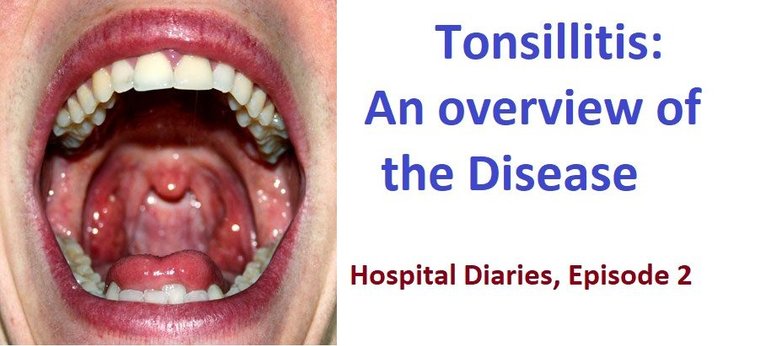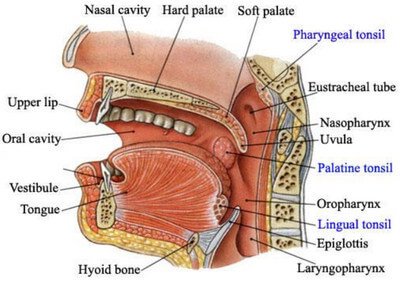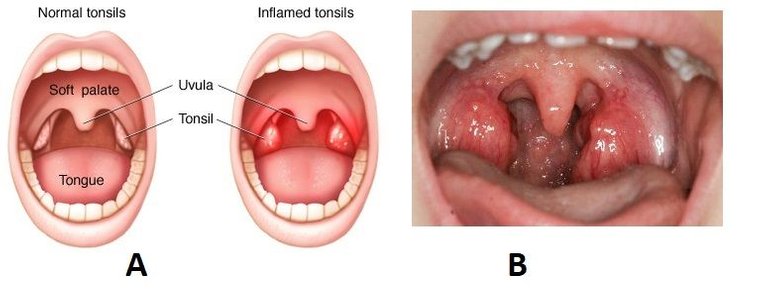
(credits)

In last episode I talked about an interesting case of Lady with eagle syndrome, you can check it here- Episode 1
Today also I will be talking about Otolaryingology(Ear, throat & Nose) case, but its a very common case unlike the Eagle syndrome .
Yesterday I saw 4-5 throat cases of which 3 were of tonsillitis, 2 of pharyngitis and one of leukoplakia. Today we will discuss about the tonsillar cases.
Out of the 3 cases 2 were in stage 2 and one was in stage 3 of the tonsillar enlargement(Will talk later about it), 2 were male of 15 & 18 yr and 1 was female of early 30s, she was the one with stage 3 enlargement.
Lets talk about the case of the lady , she presented with the chief complaint of difficulty in swallowing for last 4 days, mild fever for 4 days and earache for 1 day.
After taking the history we started examining her, ear and nose were normal but her oral mucosa was red and congested, the tonsils were enlarged and posterior pharyngeal wall showed some erythema. our professor prescribed her some meidicines and ask to follow up after a week.
After reading the case above you must have got some clue what tonsillits is, and it is likely that most of you have suffered from it, now we will talk about it in detail.
What are tonsil and the tonsillitis?
Tonsils are the lymphoid tissues present in the oral cavity and pharynx, lymphoid tissues are nothing but the group of white blood cells which protect us from pathogens. Tonsils prevent the entry of microorganisms(bacteria, fungi and ), viruses and toxins to enter further into our body. There are many mechanisms on how they do it, important ones are-
- Macrophages present in the tonsils direclty engulf the foreign intruders and also present them to other white blood cells like B & T cells for further immunological processing
- They identify the nature of pathogen and makes the body ready in case of future invaders
fig-Tonsils of oral cavity(credits)
As you can see in the picture above, the parts indicated with blue letters are the tonsils, palatine tonsils are two in number which lie on the posterior part of oral cavity between palatoglossus and palatopharyngeaus muscle; lingual tonsil lie at the base of tongue and nasopharyngeal tonsils lie at back of nasal cavity.there are other tonsils too which are not shown there, actually there is a ring of tonsils in the oral cavity known as Waldeyer's ring .
when we talk about tonsillitis the most commonly enlarged and seen are the palatine tonsils.

Fig- A, shows schematic picture comparision between normal and inflamed tonsils.B, shows tonsilar enlargement of real patient,credit-1,credit-2
How do we get tonsillitis?..The science behind it
Tonsillitis is an natural protective mechanism of the body which indicates immune activation against the entry of pathogen in the oral cavity, normally when pathogen enter the oral cavity they are neutralized without any obvious change in the structure and function of tonsills, every day thousands of bacteria and toxic things enter the oral cavity and they are counteracted by the lymphoid tissue of tonsils..
thats the reason we do not get tonsillitis everyday... but when tonsills are hyperstimulated by defect in tonsils themselves or due to attack by virulent pathogen/toxin, there occurs inflammation of tonsillar tissue with large proliferation white blood cells present in it and we develop symptoms like-
- sore throat
- Pain during swallowing
- Fever, sometimes with chills and rigor
- pain in ear
- other symptoms like - malaise, decreased appetite, body ache
Factors that aggravate tonsillitis
- consumption of cold water/beverages, hot spicy food
- Exposure to Dust, smoke
- ongoing Pharyngitis
Different types of tonsillitis
According to the course of illness it may be acute or chronic one, former being for short period of time and later having a long course with recurrent episodes of acute illness.
Morphologically, as we see there are mainly 4 types.

Fig.-Different types of tonsillitis;A-superficial tonsillitis, it involves superficial mucosal layer and tonsils are not enlarged;B-follicular type, it shows pus filled crypts seen as yellow dots;C-membraneous type,shows membrane formed by coalescence of follicles;D-parenchymatous type,tonsils are greatly enlarged
The later the stages more are the complication..
How is it treated?
Acute cases are generally treated conservatively which includes-
- Bed rest, high fluid intake
- Avoidance of very cold or hot food and spicy food items
- Analgesics for pain, Mouth gargle with antiseptics and Anti-allergic drugs
BUT, if its a recurrent and chronic case surgical removal of tonsils is the main treatment.
What happens if you do not treat it??
Well, early treatment is the best thing to do.. This disease may look very minor but if not treated lands into serious complications..
You may develop ear infection(ottitis media), abscess around the pharynx and tonsils, kidney disease(glomerulonephritis) and rheumatic heart disease..
Is it preventable?
It can be communicable if it is infective in origin, it can be prevented by maintaining proper sanitation, oral hygiene and avoiding contact with the cases..
In short:
Tonsillitis is an inflammatory condition characterized by proliferation of tonsils of oral cavity and pharynx which clinically presents as sore throat, odynophagia(pain during swallowing), fever and other constitutional symptoms.In acute cases it is treated conservatively and in recurrent and chronic ones tonsillectomy is done.
Thats all for today, if you have any experience with tonsillitis you are welcome to share it in the comments
Follow @himal for my future posts
If you like posting about science/health/math/engineering/technology check out @steemstem, a science community in steemit run by science enthusiasts

References used:
1.Disease of ENT and head and neck surgery
2.https://beta.nhs.uk/conditions/tonsillitis/?WT.mc_id=organic_split
Thanks sir for sharing such a common problem with us ! :)
Thanks for reading. Glad you likex it.. :)
Do you know what the actual function of the tonsils are? Obviously a person can survive after having a tonsillectomy, but are there any complications or difficulties to living without tonsils?
Thanks for the excellent question. Tonsils are the part of MALT(mucosa associated lymphoid tissue), the main function is to provide local immunity but in small extent also have systemic function... And its logical to think that tonsillectomy should decrease the immune function, but it is not that significant and studies have shown the same.... Yeah there are some surgical complications like bleeding, infection etc, but it increases the quality of life which is main thing to look upon... :)
This post recieved an upvote from minnowpond. If you would like to recieve upvotes from minnowpond on all your posts, simply FOLLOW @minnowpond
This post recieved an upvote from minnowpond. If you would like to recieve upvotes from minnowpond on all your posts, simply FOLLOW @minnowpond
@himal got you a $1.58 @minnowbooster upgoat, nice! (Image: pixabay.com)
Want a boost? Click here to read more!